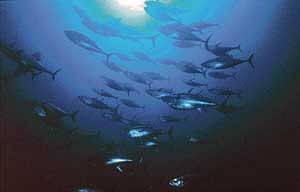
Numbers of Pacific bluefin tuna may be about to go the same way as those of their Atlantic cousins. The Pacific population was thought to be the endangered fish’s only remaining stronghold. But official reports on stock sizes have overlooked changes to fishing practices that could mean they are heading for a crash, according to recent assessments.
In the Atlantic Ocean and the Mediterranean Sea, fishing has caused tuna populations to fall below 15 per cent of their historical levels. Even so, an attempt this year to ban trade in the fish failed to gain international approval at a meeting in March of the Convention on International Trade in Endangered Species of Wild Fauna and Flora.
By contrast, Pacific bluefin (Thunnus orientalis) populations had been thought to be stable, with enough young fish maturing each year to replace those caught. In July 2009, a working group of the International Scientific Committee for Tuna and Tuna-like Species in the North Pacific Ocean (ISC) concluded that recruitment of juveniles to the population “does not appear to have been adversely affected by the relatively high rate of exploitation.”
But the working group admitted that a lack of data meant recruitment since 2005 is highly uncertain. And the belief that the stock is stable is based on a false assumption that fishing practices have not changed, says Toshio Katsukawa, a fisheries expert at Mie University in Tsu City, Japan. From speaking to fishermen, Katsukawa is most concerned that, in the past few years, boats have begun targeting the tuna’s spawning grounds. This tactic increases catches, simultaneously making the stock seem bigger but damaging the fish’s breeding capacity.
Will collapse before others
“If things go on like this, the Pacific (bluefin) populations will be the first to collapse (before the Atlantic stock),” says Katsukawa. The change in fishing practice has gone hand in hand with a growth in the market for juvenile tuna, says Chien-Chung Hsu, a fisheries biologist at the National Taiwan University in Taipei. Juveniles 1015-centimeters long fetch US$100 each in Japanese markets, he says. By contrast, adult Pacific bluefins can sell for $100,000 or more, and Katsukawa points out that fishermen could make more profit by waiting for the fish to mature. Overall, more than 70 per cent of the Pacific bluefin catch is taken by fishermen from Japan, where the fish is prized for its use in sushi.
Data from the ISC show that more than 70 per cent of Pacific bluefin tuna caught today are less than one year old, compared with around 60 per cent in the 1960s, although Katsukawa believes that even this increase is an underestimate. Over 90 pc of the catch is less than two years old. “The increasing juvenile catch is increasing the risk of population collapse,” says Hsu. “The population is dropping for all age classes and we see signs of serious problems if no management measures are set immediately.”
Measures to monitor tuna numbers
Japan’s Fisheries Agency recently outlined new measures to monitor and manage the tuna populations. These specify limits on the weight of fish that each boat can catch, restrictions for the large boats using encircling nets that account for most tuna fishing, along with new requirements for other boats to report their catches. And fish farmers, who collect an increasing but unknown number of juveniles and raise them in pens, will be required to register and report their activities. The agency plans to implement the restrictions by April 2011.
The measures also call for better information on juvenile stocks and spawning areas, and for the establishment of an international network of researchers to study and manage Pacific bluefin tuna fisheries. “To protect these spawning regions, we have to find out where they are and when the peak seasons are. Then we can start to make restrictions on which ones can be fished and when they can be fished,” says Yukio Takeuchi, a researcher at the National Research Institute of Far Seas Fisheries, an arm of the Fisheries Agency based in Shizuoka, Japan, who chaired the ISC working-group report.
Katsukawa says that the new measures, “if done effectively”, could have a major impact.
New York Times News Service
Proposal to ban tuna trade turned down
Delegates at a UN conference on endangered species in Doha, Qatar in March defeated US-supported proposals to ban international trade in bluefin tuna and to protect polar bears. Atlantic and Mediterranean stocks of bluefin, have been severely depleted by years of heavy commercial fishing, while polar bears are considered threatened by hunting and the loss of sea ice because of global warming. The United States tried unsuccessfully to persuade delegates to the Convention on International Trade in Endangered Species of Wild Fauna and Flora, or CITES, to provide strong international protection for the two species.
“It wasn’t a very good day for conservation,” said Juan Carlos Vasquez, a spokesman for the UN organisation. “It shows the governments are not ready to adopt trade bans as a way to protect species.” “The bluefin tuna is an iconic fish species,” said Tom Strickland, assistant secretary of the interior for fish and wildlife and parks. “The science is compelling, the statistics are dramatic. That species is in spectacular decline.”
He said the US had recently declared the polar bear population to be threatened by loss of its sea ice habitat to melting. The Interior Department, he said, had designated 200,000 acres of Arctic ice as critical habitat in need of protection. Canada, Greenland and several indigenous communities, contended that the bear population was healthy and that it could sustain limited hunting and trade in pelts and body parts. Japan’s argument resonated with other fishing nations, which were uneasy about what would have been the first intrusion of the endangered species convention into a major commercial fishery. But ICCAT’s own record on managing the fish is seen as unsuccessful: the bluefin population has declined by roughly 80 percent since 1970.
David Jolly and John M Broder
NYTNS